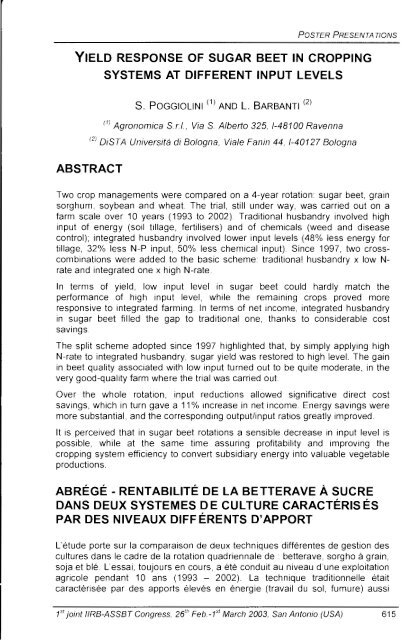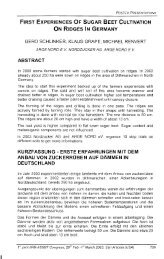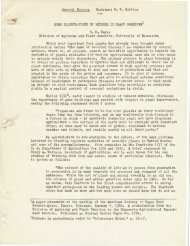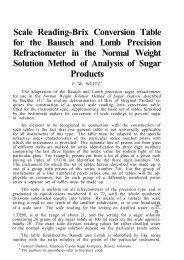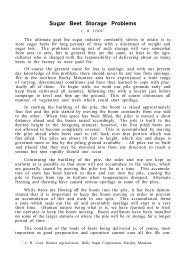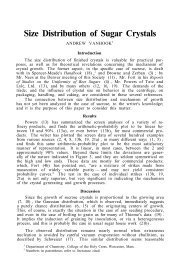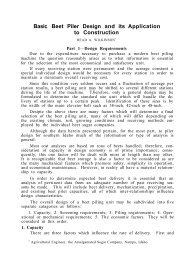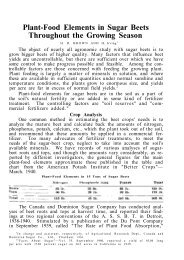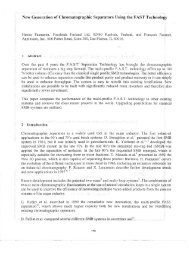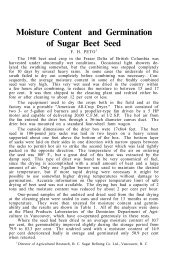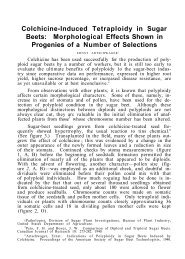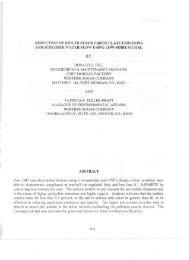yield response of sugar beet in cropping systems at different input ...
yield response of sugar beet in cropping systems at different input ...
yield response of sugar beet in cropping systems at different input ...
Create successful ePaper yourself
Turn your PDF publications into a flip-book with our unique Google optimized e-Paper software.
POSTER PRESENTATIONS<br />
YIELD RESPONSE OF SUGAR BEET IN CROPPING<br />
SYSTEMS AT DIFFERENT INPUT LEVELS<br />
S. POGGIOLINI ( 1 ) AND L. BARSANTI ( 2 )<br />
11 ! Agronomica S rl, ViaS Alberto 325, 1-48100 Ravenna<br />
12 ! DiSTA Universita di Bologna, Viale Fan<strong>in</strong> 44, 1-40127 Bologna<br />
ABSTRACT<br />
Two crop managements were compared on a 4-year rot<strong>at</strong>ion: <strong>sugar</strong> <strong>beet</strong>, gra<strong>in</strong><br />
sorghum, soybean and whe<strong>at</strong> The trial, still under way, was carried out on a<br />
farm scale over 10 years ( 1993 to 2002) Traditional husbandry <strong>in</strong>volved high<br />
<strong>in</strong>put <strong>of</strong> energy (soil tillage, fertilisers) and <strong>of</strong> chemicals (weed and disease<br />
control); <strong>in</strong>tegr<strong>at</strong>ed husbandry <strong>in</strong>volved lower <strong>in</strong>put levels (48% less energy for<br />
tillage, 32% less N-P <strong>in</strong>put, 50% less chemical <strong>in</strong>put) S<strong>in</strong>ce 1997, two crosscomb<strong>in</strong><strong>at</strong>ions<br />
were added to the basic scheme traditional husbandry x low N<br />
r<strong>at</strong>e and <strong>in</strong>tegr<strong>at</strong>ed one x high N-r<strong>at</strong>e.<br />
In terms <strong>of</strong> <strong>yield</strong>, low <strong>in</strong>put level <strong>in</strong> <strong>sugar</strong> <strong>beet</strong> could hardly m<strong>at</strong>ch the<br />
performance <strong>of</strong> high <strong>in</strong>put level, while the rema<strong>in</strong><strong>in</strong>g crops proved more<br />
responsive to <strong>in</strong>tegr<strong>at</strong>ed farm<strong>in</strong>g. In terms <strong>of</strong> net <strong>in</strong>come, <strong>in</strong>tegr<strong>at</strong>ed husbandry<br />
<strong>in</strong> <strong>sugar</strong> <strong>beet</strong> filled the gap to traditional one, thanks to considerable cost<br />
sav<strong>in</strong>gs<br />
The split scheme adopted s<strong>in</strong>ce 1997 highlighted th<strong>at</strong>, by simply apply<strong>in</strong>g high<br />
N-r<strong>at</strong>e to <strong>in</strong>tegr<strong>at</strong>ed husbandry, <strong>sugar</strong> <strong>yield</strong> was restored to high level. The ga<strong>in</strong><br />
<strong>in</strong> <strong>beet</strong> quality associ<strong>at</strong>ed with low <strong>in</strong>put turned out to be quite moder<strong>at</strong>e, <strong>in</strong> the<br />
very good-quality farm where the trial was carried out<br />
Over the whole rot<strong>at</strong>ion, <strong>in</strong>put reductions allowed signific<strong>at</strong>ive direct cost<br />
sav<strong>in</strong>gs, which <strong>in</strong> turn gave a 11% <strong>in</strong>crease <strong>in</strong> net <strong>in</strong>come Energy sav<strong>in</strong>gs were<br />
more substantial, and the correspond<strong>in</strong>g output/<strong>in</strong>put r<strong>at</strong>ios gre<strong>at</strong>ly improved.<br />
It is perceived th<strong>at</strong> <strong>in</strong> <strong>sugar</strong> <strong>beet</strong> rot<strong>at</strong>ions a sensible decrease <strong>in</strong> <strong>in</strong>put level is<br />
possible, while <strong>at</strong> the same time assur<strong>in</strong>g pr<strong>of</strong>itability and improv<strong>in</strong>g the<br />
cropp<strong>in</strong>g system efficiency to convert subsidiary energy <strong>in</strong>to valuable vegetable<br />
productions.<br />
ABREGE- RENTABILITE DE LA BETTERAVE A SUCRE<br />
DANS DEUX SYSTEMES DE CULTURE CARACTERIS ES<br />
PAR DES NIVEAUX DIFFERENTS D'APPORT<br />
L'etude porte sur Ia comparaison de deux techniques <strong>different</strong>es de gestion des<br />
cultures dans le cadre de Ia rot<strong>at</strong>ion quadriennale de : betterave, sorgho a gra<strong>in</strong>,<br />
soja et ble L'essai, toujours en cours, a ete conduit au niveau d'une exploit<strong>at</strong>ion<br />
agricole pendant 10 ans (1993 - 2002). La technique traditionnelle etait<br />
caracterisee par des apports eleves en energie (travail du sol, fumure) aussi<br />
1st jo<strong>in</strong>t 1/RB-ASSBT Congress, 26th Feb.-1st March 2003, San Antonio (USA) 615
POSTER PRESENTATIONS<br />
bien qu'en produits chimiques (lutte contre les mauvaises herbes et les<br />
maladies) ; Ia technique <strong>in</strong>tegree, par contre, comportait des apports plus<br />
reduits (48% d'energie en mo<strong>in</strong>s pour le travail du sol, 32% en mo<strong>in</strong>s pour N et<br />
P, 50% en mo<strong>in</strong>s de produits chimiques). A partir de 1997, on a ajoute deux<br />
comb<strong>in</strong>aisons croisees au schema de base : technique traditionnelle x niveau<br />
reduit de N et technique <strong>in</strong>tegree x niveau eleve de N.<br />
Pour ce qui est de Ia rentabilite, dans le cas de Ia betterave a sucre, !'apport<br />
reduit a a pe<strong>in</strong>e <strong>at</strong>te<strong>in</strong>t le niveau de performance obtenu par un apport eleve,<br />
tandis que les autres cultures ont obtenu des performances meilleures avec Ia<br />
gestion <strong>in</strong>tegree. En termes de revenu net, dans Ia betterave a sucre, Ia gestion<br />
<strong>in</strong>tegree a pu combler Ia lacune productive par rapport a Ia technique<br />
traditionnelle grace a des economies importantes de coOts.<br />
Le schema adopte a partir de 1997 a mis en evidence que Ia seule applic<strong>at</strong>ion<br />
d'une dose elevee d'azote a Ia technique <strong>in</strong>tegree est suffisante pour faire<br />
remonter Ia production en sucre a un niveau eleve.<br />
L'amelior<strong>at</strong>ion en termes de qualite de Ia betterave a sucre, dans le cas d'un<br />
apport reduit, a ete assez modeste dans !'exploit<strong>at</strong>ion ou les essais ont ete<br />
conduits, vu qu'elle etait deja caracterisee par une tres bonne qualite de<br />
production.<br />
Dans !'ensemble de Ia rot<strong>at</strong>ion, les reductions en apport ont permis des<br />
economies importantes en termes de coOts, ce qui, a son tour, a entrafne une<br />
augment<strong>at</strong>ion de 11% du revenu net Les economies d'energie ont ete encore<br />
plus importantes et les rapports production/apport correspondants ont enregistre<br />
une amelior<strong>at</strong>ion remarquable.<br />
L'etude a mis en evidence le fait qu'une reduction raisonnable du niveau<br />
d'apport dans les rot<strong>at</strong>ions de Ia betterave a sucre est possible, tout en assurant<br />
Ia rentabilite de Ia culture et en ameliorant l'efficacite du systeme de culture au<br />
moyen d'une conversion de l'energie supplementaire en production vegetale<br />
d'une certa<strong>in</strong>e valeur<br />
KURZFASSUNG- RENTABILITAT VON ZUC KERRUBEN IN<br />
ANBAUTEN MIT UNTERSCHIEDLI CHER EINBRINGUNG<br />
Zwei verschiedene Anbauverfahren wurden uber vier Jahre <strong>in</strong> e<strong>in</strong>em<br />
Rot<strong>at</strong>ionsverfahren verglichen angebaut wurden Zuckerruben, Kornerhirse,<br />
Weizen Die noch laufende Testreihe erstreckt sich uber 10 Jahre (1993- 2002)<br />
und erfolgte auf betrieblicher Ebene Das traditionelle Anbauverfahren erforderte<br />
e<strong>in</strong>e hohe E<strong>in</strong>br<strong>in</strong>gung von Energie (Bearbeitung der Felder, Dunger) und<br />
Chemie (zur Kontrolle von Unkraut und Krankheitsbefall); das <strong>in</strong>tegrierte<br />
Verfahren erforderte e<strong>in</strong>e ger<strong>in</strong>gere E<strong>in</strong>br<strong>in</strong>gung (48% weniger Energie fUr die<br />
Bearbeitung, 32% weniger N-P und 50% weniger chemische Produkte). Ab<br />
1997 wurden dem Grundschema zwei gekreuzte Komb<strong>in</strong><strong>at</strong>ionen h<strong>in</strong>zugefugt:<br />
traditionelle Anbauverfahren x ger<strong>in</strong>ger Anteil von N und <strong>in</strong>tegriertes Verfahren x<br />
hoher Anteil von N.<br />
Der Produktionsaustrag ergab, dass e<strong>in</strong>e ger<strong>in</strong>ge E<strong>in</strong>br<strong>in</strong>gung bei der<br />
Zuckerrube kaum an die Ergebnisse der hohen E<strong>in</strong>br<strong>in</strong>gung heranreicht,<br />
616 1 5 tjo<strong>in</strong>t 1/RB-ASSBT Congress, 26th Feb.-1 5 t March 2003, San Antonio (USA)
POSTER PRESENTATIONS<br />
wahrend die anderen Anbauten besser auf das <strong>in</strong>tegrierte System reagiert<br />
haben. Das <strong>in</strong>tegrierte Anbauverfahren ergab e<strong>in</strong>en Nettoaustrag der<br />
Zuckerrube, durch den der Produktionsunterschied zum traditionellen Verfahren<br />
aufgrund der erheblichen Kostene<strong>in</strong>sparungen ausgeglichen wurde.<br />
Das ab 1997 e<strong>in</strong>gefUhrte Kreuzschema h<strong>at</strong> ergeben, dass die zeitliche<br />
Verteilung des hohen Stickst<strong>of</strong>fanteils im <strong>in</strong>tegrierten Verfahren zu e<strong>in</strong>em hohen<br />
Zuckergehalt der Rube fUhrte. Die Qualit<strong>at</strong>sverbesserung der Zuckerrube im<br />
Verfahren mit ger<strong>in</strong>ger E<strong>in</strong>br<strong>in</strong>gung war im Versuchsbetrieb durch e<strong>in</strong>e hohe<br />
Ausgangsqualit<strong>at</strong> rel<strong>at</strong>iv niedrig.<br />
lm Rahmen der Rot<strong>at</strong>ion ergaben die Kurzungen <strong>in</strong> der E<strong>in</strong>br<strong>in</strong>gung erhebliche<br />
Kostene<strong>in</strong>sparungen, die zu e<strong>in</strong>er Steigerung des Netto-Betriebsergebnisses<br />
von 11% geflihrt haben. Die Energiee<strong>in</strong>sparungen lagen noch hoher und die<br />
entsprechenden outpuU<strong>in</strong>put Verhaltnisse konnten erheblich verbessert werden.<br />
Das Ergebnis zeigt wie e<strong>in</strong>e vernunftige Reduktion des E<strong>in</strong>br<strong>in</strong>gungsniveaus <strong>in</strong><br />
der Rot<strong>at</strong>ion von Zuckerrubenanbau moglich ist bei gleichzeitiger Rentabilit<strong>at</strong><br />
und e<strong>in</strong>er verbesserten Effizienz des Anbau<strong>systems</strong> durch e<strong>in</strong>e zus<strong>at</strong>zliche<br />
ZufUhrung von Energie <strong>in</strong> hochwertige Pflanzenproduktionen.<br />
INTRODUCTION<br />
Sugar <strong>beet</strong> is a crop th<strong>at</strong> cannot be grown on the same soil very <strong>of</strong>ten, <strong>in</strong> order<br />
to mitig<strong>at</strong>e soil pests and diseases. For this reason, three- and four-year<br />
rot<strong>at</strong>ions are most common <strong>in</strong> <strong>sugar</strong> <strong>beet</strong> areas throughout the world. The study<br />
<strong>of</strong> the <strong>beet</strong> crop as part <strong>of</strong> a rot<strong>at</strong>ion is <strong>of</strong> gre<strong>at</strong> <strong>in</strong>terest and gives h<strong>in</strong>ts <strong>at</strong> how to<br />
f<strong>in</strong>e-tune the whole rot<strong>at</strong>ion <strong>in</strong> terms <strong>of</strong> <strong>at</strong>ta<strong>in</strong>able <strong>yield</strong>s, costs, <strong>in</strong>put efficiency.<br />
MATERIALS AND METHODS<br />
In the ten years 1993 to 2002 a four-crop rot<strong>at</strong>ion was established on ten<br />
hectares <strong>at</strong> Ca Bosco farm, near Ravenna (Northern Italy) The four crops were<br />
<strong>sugar</strong> <strong>beet</strong>, gra<strong>in</strong> sorghum, soybean and whe<strong>at</strong>, all present <strong>in</strong> every year and<br />
rot<strong>at</strong><strong>in</strong>g on four plots. Each crop was splitted <strong>in</strong>to two parts <strong>at</strong> <strong>different</strong> <strong>in</strong>put<br />
levels a high one, reflect<strong>in</strong>g the traditional husbandry ensur<strong>in</strong>g a good <strong>yield</strong><br />
regardless <strong>of</strong> costs; and a low one, represent<strong>in</strong>g an <strong>in</strong>tegr<strong>at</strong>ed husbandry,<br />
allow<strong>in</strong>g signific<strong>at</strong>ive sav<strong>in</strong>gs <strong>in</strong> soil tillage, fertilisers and pesticides, on the base<br />
<strong>of</strong> recent experiences <strong>in</strong> consev<strong>at</strong>ive tillage and <strong>in</strong> guided protection, weed<br />
control and fertilis<strong>at</strong>ion<br />
In the years 1997 to 2002 two cross comb<strong>in</strong><strong>at</strong>ion were added by splitt<strong>in</strong>g the<br />
basic scheme traditional husbandry (tillage, protection) x low N-r<strong>at</strong>e and<br />
<strong>in</strong>tegr<strong>at</strong>ed one x high N-r<strong>at</strong>e (fig.1 ).<br />
RESULTS AND DISCUSS! ON<br />
In the years 1993 to 2002 <strong>sugar</strong> <strong>yield</strong> ranged from 5 to 12 Uha, accord<strong>in</strong>g to the<br />
season's potential (fig. 2). Traditional husbandry prevailed on <strong>in</strong>tegr<strong>at</strong>ed one<br />
seven years out <strong>of</strong> ten. The average difference over the decade was 0,9 Uha,<br />
1st jo<strong>in</strong>t 1/RB-ASSBT Congress, 26th Feb.-1st March 2003, San Antonio (USA) 617
POSTER PRESENTATIONS<br />
Figure 1: Expcr<strong>in</strong>tcntnl Scltcntc<br />
Traditional Integr<strong>at</strong>ed Traditio na J Integra ted Traditiona I Integr<strong>at</strong>ed T rad itiona I Integr<strong>at</strong>ed<br />
N -r<strong>at</strong>e N-r<strong>at</strong>e N -r<strong>at</strong>e N -r<strong>at</strong>e<br />
fi!_,l!<br />
L CJ\/1/<br />
H:c;H<br />
L\_''VV<br />
/:\ /:\ /:\ /:\<br />
tl'(,j; o·.~ .. 1~ I(; H LOW<br />
/:\ /:\ /:\ /:\<br />
tltl,ll II -j,(-H II ',)V\i flll,l1 I L,)V\,' IIIC,H I 1 nw<br />
I<br />
I<br />
I<br />
I<br />
I<br />
I<br />
I<br />
I<br />
I<br />
I<br />
I<br />
I<br />
I<br />
r-- -~;:;'1997----.<br />
I Tradtltonal x Low N-r<strong>at</strong>e I<br />
I L_ __________ lntegr.Jtcd x Htgh N r<strong>at</strong>e _. I<br />
~<br />
I<br />
I<br />
I<br />
I<br />
I<br />
I<br />
I<br />
I<br />
I<br />
I<br />
I<br />
I<br />
I<br />
I<br />
~<br />
I<br />
Hlc_,H I 1 nw HICoH I Lc.'•W llk;11 ltcwv<br />
I I I<br />
HIC;I-I I nw<br />
I<br />
I I I I<br />
I I I I<br />
I I I I<br />
I I I I<br />
I<br />
I<br />
~<br />
I<br />
~<br />
I<br />
I I I I<br />
!<br />
correspond<strong>in</strong>g to + 12%. No trend <strong>in</strong> time seems to exist large <strong>yield</strong> gaps, about<br />
2 t/ha or more, occurred repe<strong>at</strong>edly from the beg<strong>in</strong>n<strong>in</strong>g to the end <strong>of</strong> the trial<br />
Likewise, differences did not seem to depend on the <strong>yield</strong> potential <strong>of</strong> the year It<br />
is perceived, therefore, th<strong>at</strong> large differences were not due to a lack <strong>of</strong><br />
experience <strong>in</strong> the set-up <strong>of</strong> <strong>in</strong>tegr<strong>at</strong>ed farm<strong>in</strong>g<br />
f-igure 2: Sugor Yield: Fmdition<strong>of</strong>il/1{1/ntegmtcd !tusf,iuulry.<br />
13<br />
co<br />
..c<br />
12<br />
-::::.<br />
•<br />
11 I "<br />
"'0<br />
• '<br />
10<br />
Q)<br />
"<br />
>- 9<br />
...<br />
co 8<br />
~'<br />
Cl •<br />
~ .'I<br />
::::l<br />
f/) 7<br />
f/)<br />
f/)<br />
6<br />
0<br />
...<br />
C) 5<br />
4<br />
• . ... '-<br />
., ·,~<br />
'\ ·--•/ \ .. _,I<br />
• I<br />
\~/<br />
.·/'" • '\. ~<br />
. ~<br />
v .. v<br />
' '<br />
1993 1994 1995 1996 1997 1998 1999 2000 2001 2002<br />
- -• -Traditional -•.--Integr<strong>at</strong>ed<br />
As for quality, a reversed p<strong>at</strong>tern was observed <strong>in</strong>tegr<strong>at</strong>ed <strong>sugar</strong> <strong>beet</strong> grow<strong>in</strong>g<br />
performed better than traditional one <strong>in</strong> 9 years out <strong>of</strong> 10 (fig. 3).<br />
618 1 5 tjo<strong>in</strong>t 1/RB-ASSBT Congress, 26th Feb.-1st March 2003, San Antonio (USA)
POSTER PRESENTATIONS<br />
Figure 3:<br />
Juice Purity: Tmditiona/ and lntcgmtcd lrns/Ji7Jlifry.<br />
96<br />
95<br />
94<br />
~<br />
a.<br />
'<br />
93<br />
92<br />
91<br />
90<br />
•<br />
1993 1994 1995 1996 1997 1998 1999 2000 2001 2002<br />
• -• _ Tra ditiona I • Integr<strong>at</strong>ed<br />
The average difference was quite signific<strong>at</strong>ive (0,9% <strong>of</strong> JUice purity), but it must<br />
be considered th<strong>at</strong> <strong>in</strong> the traditional crop, quality was already set <strong>at</strong> a very high<br />
level It is perceived th<strong>at</strong> <strong>in</strong>tegr<strong>at</strong>ed farm<strong>in</strong>g positively affected quality thanks to<br />
lower N-applic<strong>at</strong>ions. as it is confirmed by a lower level <strong>of</strong> N impurities <strong>in</strong> the<br />
roots (table 1 ).<br />
1\Jn<strong>in</strong>o-N: Fmditional and lutegmted luJs/Jandry. 1\uemge Jl)LJ.l fo2()().'J.<br />
The associ<strong>at</strong>ion between better quality and lower <strong>yield</strong> highlighted the role <strong>of</strong> N<br />
nutrition <strong>in</strong> <strong>in</strong>tegr<strong>at</strong>ed farm<strong>in</strong>g. In fact, <strong>in</strong> the years 1997 to 2002 the splitscheme<br />
(fig 4) showed th<strong>at</strong>. by simply apply<strong>in</strong>g high N-r<strong>at</strong>e to the <strong>in</strong>tegr<strong>at</strong>ed<br />
crop, <strong>sugar</strong> <strong>yield</strong> was restored to high level and, more important, net <strong>in</strong>come<br />
benefitted even more (fig 5), thanks to cost sav<strong>in</strong>gs.<br />
Sugar <strong>beet</strong> was the only <strong>of</strong> the four crops to show sensitivity to N-nutrition; the<br />
other three performed more evenly, regardless <strong>of</strong> <strong>in</strong>put level The overall results<br />
<strong>of</strong> the rot<strong>at</strong>ion over the decade (fig 5) highlight a slight decrease <strong>in</strong> gross<br />
revenue, but a signific<strong>at</strong>ive <strong>in</strong>crease <strong>in</strong> net <strong>in</strong>come for <strong>in</strong>tegr<strong>at</strong>ed farm<strong>in</strong>g, thanks<br />
to considerable cost reductions In terms <strong>of</strong> energy balance too, <strong>in</strong>tegr<strong>at</strong>ed<br />
farm<strong>in</strong>g proved more efficient than traditional one: <strong>in</strong> other words, <strong>in</strong>put<br />
reductions did not affect output level<br />
1st jo<strong>in</strong>t 1/RB-ASSBT Congress. 26th Feb.-1st March 2003. San Antonio (USA) 619
POSTER PRESENTATIONS<br />
Figure 4:<br />
Sugar )'icld. Aucmgc 1997 to2002.<br />
(1)<br />
z<br />
·;. .c<br />
.... Cl<br />
100<br />
nl ·-<br />
e>I<br />
:::l<br />
-ri<br />
95<br />
til<br />
til<br />
nl<br />
....<br />
til<br />
0<br />
1-<br />
90<br />
... II<br />
C) 0<br />
0<br />
85<br />
80<br />
Traditional<br />
Integr<strong>at</strong>ed<br />
IIJHigh N-r<strong>at</strong>e oLow N-ra te<br />
Fiou rc r:; ·<br />
(\ ' . Sugar Hcct Net lnco/Jic- 1997 to2002.<br />
130<br />
125<br />
(1)<br />
-nl 120<br />
...<br />
'<br />
z<br />
(1) 115<br />
E .c<br />
Cl<br />
0<br />
I 110<br />
0<br />
1:<br />
-ri<br />
..... 105<br />
nl<br />
(1) ...<br />
z 1- 100<br />
II<br />
0<br />
0<br />
95<br />
90<br />
85<br />
Traditional<br />
Integr<strong>at</strong>ed<br />
~!i]High<br />
N-r<strong>at</strong>e oLow N-r<strong>at</strong>e<br />
CONCLUSIONS<br />
• The approach <strong>of</strong> <strong>in</strong>tegr<strong>at</strong>ed farm<strong>in</strong>g leads to cropp<strong>in</strong>g <strong>systems</strong> fe<strong>at</strong>ur<strong>in</strong>g<br />
lower <strong>in</strong>puts associ<strong>at</strong>ed with lower costs and, <strong>in</strong> perspective, better<br />
environmental respect<br />
620 1st jo<strong>in</strong>t 1/RB-ASSBT Congress, 26th Feb.-1st March 2003, San Antonio (USA)
POSTER PRESENTATIONS<br />
Figure 6: Integr<strong>at</strong>ed us Tmditionolllllshmulry <strong>in</strong> 114-crop rototion mwr 10 IJi'llrs.<br />
Cost-18%<br />
120<br />
Output/Input +17%<br />
Revenue -2%<br />
Input -18%<br />
~Integr<strong>at</strong>ed Husbandry- -• _Traditional Husbandry<br />
• In this framework, <strong>sugar</strong> <strong>beet</strong> proved a sensitive crop husbandry must be<br />
f<strong>in</strong>e-tuned with gre<strong>at</strong> accuracy, <strong>in</strong> order to avoid <strong>yield</strong> losses without<br />
correspond<strong>in</strong>g quality benefits. More <strong>in</strong> detail, it appears th<strong>at</strong> not all <strong>in</strong>puts<br />
may be curbed simultaneously to the level they can stand when reduced<br />
s<strong>in</strong>gularly.<br />
• For the gra<strong>in</strong> crops (whe<strong>at</strong>, sorghum, soybean), there is a lower sensitivity<br />
to this problem, then a wider marg<strong>in</strong> <strong>of</strong> reduction avoid<strong>in</strong>g the risk <strong>of</strong><br />
neg<strong>at</strong>ive consequences<br />
• Over the whole rot<strong>at</strong>ion, <strong>in</strong>tegr<strong>at</strong>ed farm<strong>in</strong>g improved both pr<strong>of</strong>itability and<br />
the efficiency to convert energy <strong>in</strong>to valuable productions<br />
REFERENCES<br />
1 GOODLAND, R The concept <strong>of</strong> environmental susta<strong>in</strong>ablity Annu. Rev.<br />
Ecol. Sys. 26 1-24, 1995<br />
2. KAFFKA, S.R & HILLS, F J: Sugar<strong>beet</strong>. In: Encyclopedia <strong>of</strong> Agricultural<br />
Science, Academic Press, New York, 1994.<br />
3. PERUCH, U eta/. Verifica agronomica, ambientale ed economica di due<br />
it<strong>in</strong>erari <strong>in</strong>tegr<strong>at</strong>i a diverso livello di <strong>in</strong>put su un sistema a scala aziendale.<br />
Agrico/tura e Ricerca, no 164-165-166, 1997.<br />
4. PIMENTEL, D. eta/: Ecological Resource Management for a Productive,<br />
Susta<strong>in</strong>able Agriculture. In Food and N<strong>at</strong>ural Resources, Ed. by Pimentel<br />
0 and Hall C. W., Academic Press, Inc, 12 301-323, 1989.<br />
1 51 jo<strong>in</strong>t 1/RB-ASSBT Congress. 26th Feb.-1st March 2003, San Antonio (USA) 621


